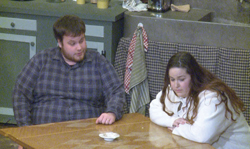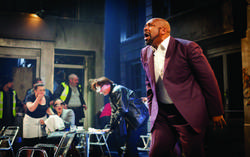“Crimes of the Heart” Didn’t Rob Audiences of Drama
 I’m usually not one who goes to see plays, or other styles of theatrical performance. Despite this, I still enjoy a good play, and “Crimes of the Heart” delivered. I was also happy that this wasn’t a musical. Seriously, so many TV programs nowadays are about singing and dancing that it sort of produced a stereotype that all shows were happy-go-lucky musicals (at least for me). Thankfully “Crimes of the Heart” broke this self-induced mold for me and showed me a serious, yet darkly humorous dilemma.
I’m usually not one who goes to see plays, or other styles of theatrical performance. Despite this, I still enjoy a good play, and “Crimes of the Heart” delivered. I was also happy that this wasn’t a musical. Seriously, so many TV programs nowadays are about singing and dancing that it sort of produced a stereotype that all shows were happy-go-lucky musicals (at least for me). Thankfully “Crimes of the Heart” broke this self-induced mold for me and showed me a serious, yet darkly humorous dilemma.
It was easy to see that the crew wanted to put on a play that would entertain as many as possible. The stage set alone was enough to give this impression. The amount of detail set designer Ferdinando DelGuercio put into it is impressive to say the least. It legitimately looked like a house in the late 1970s, with an old refrigerator, matches instead of lighters, and one of those phones with the extremely long cord.
Not much was done lighting wise, save for cuing up the next scene. The only time a different technique was used was with the ending, which I’ll cover later.
The acting itself was phenomenal. Keep in mind that these are students just like you and me, and they had to put up with class before this. Some also had to act in another play right before this one as well. As such, you have to admire them for remembering their cues, lines, and even keeping their Southern accents. Since I’m a lifelong resident of New Jersey, I can’t say whether the accents were accurate or not, but the actors convinced me that these were characters from the South.
The stars of the show were the three sisters. Lenny is the oldest sister, a quiet woman looking after their sick grandfather. Meg is the middle sister, she left for Hollywood to be a singer but found minimal work and wound up working in a dog food factory. Babe, the youngest sister, is married to an abusive husband. The story starts with Babe shooting her husband in an attempt to kill him.
The actresses did a very good job as the sisters. They were able to act out the scenes in a way that seemed very natural, like this was a real life event unfolding before us. Melanie Miller, an attendant of the show, said that “the 3 sisters have a very good chemistry together. It’s like they really are sisters.”
Allie Miller did a great job as the quiet yet envious Lenny. Liz Anderson convinced me that Meg was a careless woman with little concern for those besides her. Alex Appolonia was an excellent Babe. Not only did she look considerably younger than the other two, but she also acted the part of a young woman collapsing from the pressure.
The rest of the supporting cast was also good. Barnette Lloyd, Babe’s lawyer is a shy character and there is an implied budding romance between him and Babe. Michael Rosas did a very good as the stuttering and embarrassed lawyer taking on his first case.
Lauren Lambert did a great job as Chick, the sisters’ cousin, being a control freak, not to mention the obvious conflict to the three sisters. Henry O. Siebecker was a great Doc Porter, even though his stage time was the shortest. Diego Allessandro, 27, was also impressed with the acting. He thought it was “thoroughly enjoyable and a good example of the talent we have at Monmouth.”
Keep in mind that I only saw one show, so I can’t say how the other cast did. This is a double cast show, meaning that two different casts act on alternate nights. The only actor who did played their character in both casts was Henry O. Siebecker. I have to applaud him for being able to keep up with the play for the 2 weeks worth of shows he had to act in.
I’m certain that the other cast was just as great. Amanda Grubr, a sophomore, had the pleasure to see both casts and enjoyed both of them.
As far as the content itself, the play is a dark comedy about a serious situation. Babe is facing the very real possibility of going to jail for shooting her husband. The three sisters themselves have conflicting personalities and hidden bitterness toward each others. Even so, there are points where the audience was laughing even though they really shouldn’t have.
One example is when one character tries to hang themselves on a chandelier. This is a serious situation, but turns to laughter when we hear the light crash and the character walks back on set with a rope around their neck carrying the broken light. It isn’t something that you should find funny, but you can’t help but chuckle at it.
The only gripe I had with the play was the ending. Unfortunately we don’t get to see what becomes of the family, whether they overcome this obstacle or not. Instead, all we see are the three sisters hugging around a birthday cake.
This is quite a letdown of an ending, but it isn’t something to be blamed on the production. This is the ending of the original play, so if you have a problem, write a complaint to the original author.
Not everyone was disappointed with the ending however. Professor Delguercio of the English department said that she “liked the ending very much” because it had an optimistic tone.
Unfortunately this play is no longer in production. What it did do however was convince me that the Theatre department is capable of producing very enjoyable and entertaining works worth watching and supporting. I can’t rate a play, so I’ll instead encourage anyone reading this to check out what the Theatre department has in store and support them any way you can.
PHOTO COURTESY of Dan Villanova


